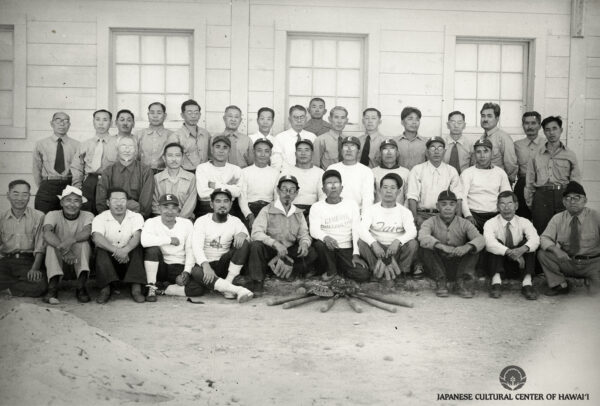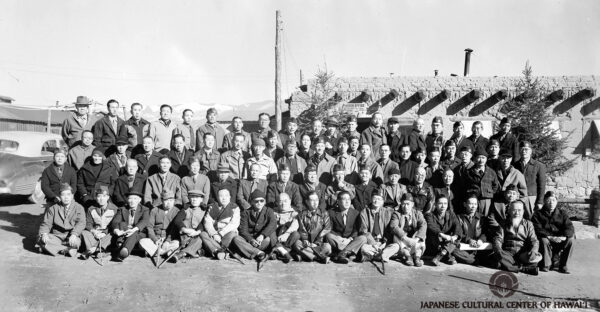Group Media & Photos

Softball players. Missoula Internment Camp, ca. 1943-1944. Front Row (L-R): Rev. Joei Oi (1st), Rev. Shushin Matsubayashi (3rd), Masayuki Chikuma (5th), Rev. Konin Matano (6th), Osuke Shigemoto (7th), Hideyuki Serizawa (10th), Ichitaro Charles Hasebe. Middle Row (L-R): Rev. Gikyo Kuchiba (1st), Totaro Matsui (2nd), Kinzo Sayegusa (4th), Kumaji Furuya (5th), Sawajiro Ozaki (6th). Back Row (L-R): Rev. Hakuai Oda (2nd), Daizo Sumida (6th), Rev. Josen Deme (10th), Rev. Gendo Okawa (11th), Taichi Sato (13th), Rev. Kaneki Honda (14th), Aisuke Shigekuni (15th), Setsuzo Toyota (16th). JCCH/Rev. Hakuai Oda Collection.

Hawaii Internees in front of Liaison Office. Santa Fe Internment Camp, January 1945. Front Row (L-R): Kumaji Furuya, Shujiro Takakuwa, Mankichi Goto, Chosuke Kayahara, Suekichi Oka, Nisshu Kobayashi, Shuji Mikami, Sadasuke Hamamoto, Konin Matano, Isaku Orita, Makitaro Tamura, Minosuke Hanabusa, Giichi Sasaki, Ryosen Yonahara, Tomiji Kimura, Ninryo Nago, Shin Yoshida. 2nd Row: Katsuichi Tanaka, Yasuemon Miki, Ryoichi Tanaka, Hatsutaro Toyofuku, Toshio Iinuma, Masaichi Hirashima, Tamaichi Tanaka, Uemon Ida, Kinai Ikuma, Hanzo Shimoda, Yoshizo Ishikawa, Taira Ida, Katsuichi Kawamoto, Daizo Sumida, Aisuke Shigekuni, Sadato Morifuji. 3rd Row: Takegoro Kusao, Setsuzo Toyota, Jinshichi Tokairin, Hidekichi Nakamoto, Gendo Okawa, Joei Oi, Yasutaro Soga, Zensuke Kurosawa, Tsunetaro Harada, Tamaki Arita, Hego Fuchino, Kogan Yoshizumi, Osuke Shigemoto, Hakuai Oda, Shinri Sarashina, Yoshinobu Sasaki, Unknown, Seiichi Fujii, Tokikichi Sugimoto, Shuntaro Ikezawa, Goki Tatsuguchi, Suekuma Takaki. Back Row: unknown, Suijo Kabashima, Koichi Iida, Sawajiro Ozaki, Shoho Fujiie, unknown, Shigeki Mizumoto, Soichi Obata, Muneo Kimura, Yukihide Kohatsu, Tomoichi Hayashi, Kakujiro Nishiki, Takeo Miyagi, Josen Deme, Gikyo Kuchiba, Eita Sato, Ryuichi Kashima, Hideyuki Serizawa, Kinzo Sayegusa. JCCH/Rev. Hakuai Oda Collection.
Arrested: December 1941
Sand Island Internment Camp, Honolulu, Oahu Island
A group of 172 Hawaii men (mostly Issei) were sent aboard the military transport ship USS U.S. Grant for internment in U.S. Army and Department of Justice camps on the Mainland. Together, the men were sent from camp to camp.
In June 1943, this transfer group was split into two, with this group sent from Camp Livingston to Fort Missoula before being transferred to the Santa Fe Camp.
From there, some internees were paroled to War Relocation Authority camps, where they were reunited with family members. Others were transferred for repatriation to Japan.
Angel Island Detention Facility, California
March 1942
Camp McCoy Internment Camp, Wisconsin
March 1942 - May 1942
Camp Forrest Internment Camp, Tennessee
May 1942 - June 1942
Camp Livingston Internment Camp, Louisiana
June 1942 - June 1943
Fort Missoula Internment Camp, Montana
June 1943 - April 1944
Santa Fe Internment Camp, New Mexico
April 1944 - October 1945
Returned to Hawaii: November 1945
Arrived in Honolulu with 450 other internees aboard the military troopship the Yarmouth.
Hideyuki Serizawa emigrated to Hawaii from Shizuoka Prefecture in 1912. He worked as a Japanese language school teacher in Kona and Hilo on the Big Island before moving his family to Honolulu in the late 1920s.
In 1941, twenty-year-old son Nobuo Pete Serizawa was working as a laborer with the U.S. Forest Service in Missoula County, Montana, not far from what would become the Fort Missoula Interment Camp, where the elder Serizawa would spend a year of confinement. In November 1941, Nobuo was inducted into the U.S. Army and served throughout the war as a member of the 100th Infantry Battalion.
Hideyuki Serizawa returned to Honolulu after internment and continued to teach Japanese at Toyo Gakuen. His eldest son, Toshio Serizawa, would become a member of the state Legislature representing Hilo.
